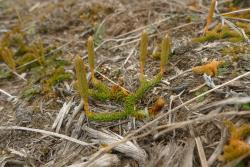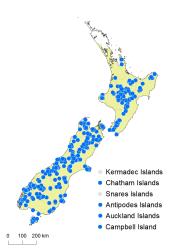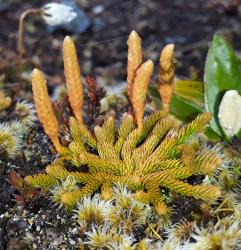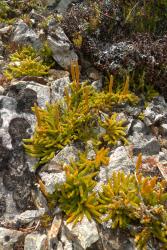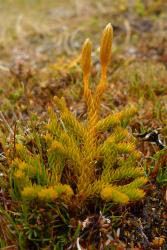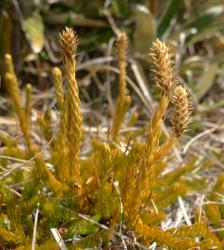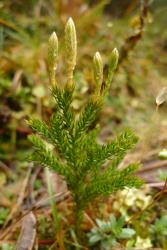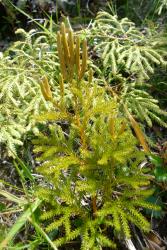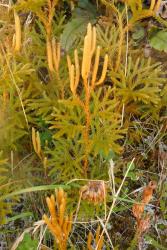- Taxon
- Gallery
- ≡ Lycopodium clavatum var. fastigiatum (R.Br.) Benth., Fl. Austral. 7, 675 (1878)
- ≡ Austrolycopodium fastigiatum (R.Br.) Holub, Folia Geobot. Phytotax. 26: 91 (1991)
- = Lycopodium curvifolium Colenso, Trans. & Proc. New Zealand Inst. 20: 234 (1888) nom. illeg., non Lycopodium curvifolium Grev. & Hook. 1831
- ≡ Lycopodium arcitenentis Herter, Index Lycopod. 5 (1949) nom. nov. pro Lycopodium curvifolium Colenso 1888
- = Lycopodium scopulosum Colenso, Trans. & Proc. New Zealand Inst. 20: 235 (1888)
- = Lycopodium decurrens Colenso, Trans. & Proc. New Zealand Inst. 28: 617 (1896) nom. illeg., non Lycopodium decurrens R.Br. 1810
- = Lycopodium magellanicum var. berggrenii Herter ex Nessel, Revista Sudamer. Bot. 6: 170, t. 16, f. 86 (1940)
- ≡ Lycopodium berggrenii (Herter ex Nessel) Herter, Index Lycopod. 6 (1949)
- = Lycopodium cochinchense Herter ex Nessel, Revista Sudamer. Bot. 6: 172 (1940)
Horizontal stems dichotomously branching, subterranean, 0.9–2.5 mm diameter, bearing roots at intervals; leaves colourless, widely spaced, appressed or spreading, ovate, adnate. Aerial stems erect or prostrate with ends upturned, not flattened in one plane, branching monopodial, glabrous; longest fertile stems 20–520 mm long (including strobili), 10–210 mm wide; unbranched portion of stem 5–240 mm long, branched portion 25–380 mm long. Branches ascending. Sterile leaves monomorphic, spirally arranged or roughly whorled, dull green or orange-brown; leaves on aerial stems incurved, linear or narrowly ovate, apices acuminate, margins entire, bases adnate, 2.5–7.5 mm long, 0.3–1.0 mm wide. Sporophylls appressed when young, spreading at maturity, ovate to broadly ovate, apices acute or acuminate, 2.4–4.5 mm long, 0.7–1.2 mm wide, with brown centres and minutely erose, membranous margins, bases peltate, aggregated into strobili. Strobili solitary or in clusters of 2–3 (rarely, one or more may be divided dichotomously), erect, yellow to brown, 5–100 mm long, 3.5–9.5 mm wide, borne on sparsely leaved stalks or rarely sessile; unbranched stalks 5–80 mm long, terminal on aerial branches, erect, bearing leaves in widely spaced rough whorls.
Lycopodium fastigiatum is recognised by its much-branched and diverging aerial stems bearing linear, incurved leaves, and strobili that are solitary or borne in clusters of two or three at the end of sparsely leaved stalks. It is distinguished from L. deuterodensum by its stalked rather than sessile strobili, and from L. scariosum and L. volubile by its diverging aerial stems with monomorphic leaves rather than flattened aerial stems with dimorphic leaves.
North Island: Auckland, Volcanic Plateau, Gisborne, Taranaki, Southern North Island.
South Island: Western Nelson, Sounds-Nelson, Marlborough, Westland, Canterbury, Otago, Southland, Fiordland.
Chatham Islands, Stewart Island, Antipodes Island, Auckland Islands, Campbell Island.
Altitudinal range: 5–1750 m.
Lycopodium fastigiatum occurs in montane to subalpine regions of the North Island from Coromandel and East Cape, south to the Tararua and Aorangi Ranges. It grows from 420 m near Wellington, up to 1580 m in the northern Ruahine Range. In the South Island it occurs in montane to subalpine areas throughout, mostly from 450 m, up to 1750 m near Mt Cook. However, it is found down to 300 m in Fiordland and Southland, and at lower altitudes, almost to sea level, on the Chatham Islands, Stewart Island and all subantarctic islands except the Snares.
Also Australia (New South Wales, Victoria, Tasmania).
Lycopodium fastigiatum grows terrestrially in open podocarp, beech and broadleaved forest, under mānuka, in Dracophyllum and Olearia scrub, on forest margins, on road or river banks, in tussock grassland, in subalpine shrubland, herbfield and bog, and in rock crevices and open rocky ground. It occurs on greywacke, limestone and a variety of volcanic rock types.
2n = 60 (Murray & de Lange 2013).
Lycopodium decurrens was described by Colenso (1896), but is illegitimate because of an earlier homonym (Brown 1810). It has traditionally been included in the synonymy of L. fastigiatum (Cheeseman 1906, 1925; Allan 1961) but no specimens of this taxon are extant in AK, K or WELT, and its identity remains uncertain.
Lycopodium cochinchinense was described by Nessel (1940) from material said to have been collected in Cochinchina and from Rotorua, New Zealand. Øllgaard (1987, 1989) treated it as a synonym of L. fastigiatum and designated the specimen from Cochinchina as the lectotype, although he said it was probably mislabelled. Lycopodium fastigiatum occurs only in New Zealand and Australia.
The name Lycopodium magellanicum P.Beauv., and combinations based on it, as used in earlier New Zealand Floras, are misidentifications of L. fastigiatum, but Lycopodium magellanicum var. berggrenii Herter ex Nessel is based on a New Zealand type and treated as a synonym of L. fastigiatum by Øllgaard (1987). The holotype was collected by Berggren from Omatangi, Taupō, in 1875 (Nessel 1940).
Lycopodium fastigiatum var. colensoi Nessel was originally described from New South Wales and from Jacksons, Arthur’s Pass, New Zealand (Nessel 1939), but the description was invalid because no Latin diagnosis was provided. Nessel (1940) later validly described the variety, citing only the holotype collected by von Mueller from New South Wales (with specimens in K, P, W and Herb. Boissier), with no mention of the New Zealand specimen. The name is therefore based on an Australian type and not included in the synonymy here.



